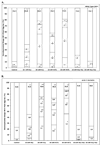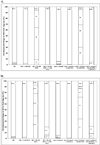Defective responses to oxidative stress in protein l-isoaspartyl repair-deficient Caenorhabditis elegans
- PMID: 19682488
- PMCID: PMC2757507
- DOI: 10.1016/j.mad.2009.08.002
Defective responses to oxidative stress in protein l-isoaspartyl repair-deficient Caenorhabditis elegans
Abstract
We have shown that Caenorhabditis elegans lacking the PCM-1 protein repair l-isoaspartyl methyltransferase are more sensitive to oxidative stress than wild-type nematodes. Exposure to the redox-cycling quinone juglone upon exit from dauer diapause results in defective egg-laying (Egl phenotype) in the pcm-1 mutants only. Treatment with paraquat, a redox-cycling dipyridyl, causes a more severe developmental delay at the second larval stage in pcm-1 mutants than in wild-type nematodes. Finally, exposure to homocysteine and homocysteine thiolactone, molecules that can induce oxidative stress via distinct mechanisms, results in a more pronounced delay in development at the first larval stage in pcm-1 mutants than in wild-type animals. Homocysteine treatment also induced the Egl phenotype in mutant but not wild-type nematodes. All of the effects of these agents were reversed upon addition of vitamin C, indicating that the developmental delay and egg-laying defects result from oxidative stress. Furthermore, we have demonstrated that a mutation in the gene encoding the insulin-like receptor DAF-2 suppresses the Egl phenotype in pcm-1 mutants treated with juglone. Our results support a role of PCM-1 in the cellular responses mediated by the DAF-2 insulin-like signaling pathway in C. elegans for optimal protection against oxidative stress.
Figures






Similar articles
-
The interplay between protein L-isoaspartyl methyltransferase activity and insulin-like signaling to extend lifespan in Caenorhabditis elegans.PLoS One. 2011;6(6):e20850. doi: 10.1371/journal.pone.0020850. Epub 2011 Jun 13. PLoS One. 2011. PMID: 21695191 Free PMC article.
-
The protein L-isoaspartyl-O-methyltransferase functions in the Caenorhabditis elegans stress response.Mech Ageing Dev. 2008 Dec;129(12):752-8. doi: 10.1016/j.mad.2008.09.019. Epub 2008 Oct 14. Mech Ageing Dev. 2008. PMID: 18977240 Free PMC article.
-
Autophagy and insulin/TOR signaling in Caenorhabditis elegans pcm-1 protein repair mutants.Autophagy. 2007 Jul-Aug;3(4):357-9. doi: 10.4161/auto.4143. Epub 2007 Jul 15. Autophagy. 2007. PMID: 17404495
-
Protein-repair and hormone-signaling pathways specify dauer and adult longevity and dauer development in Caenorhabditis elegans.J Gerontol A Biol Sci Med Sci. 2008 Aug;63(8):798-808. doi: 10.1093/gerona/63.8.798. J Gerontol A Biol Sci Med Sci. 2008. PMID: 18772467 Free PMC article.
-
Alternate metabolism during the dauer stage of the nematode Caenorhabditis elegans.Exp Gerontol. 2005 Nov;40(11):850-6. doi: 10.1016/j.exger.2005.09.006. Epub 2005 Oct 10. Exp Gerontol. 2005. PMID: 16221538 Review.
Cited by
-
Chemically induced oxidative stress affects ASH neuronal function and behavior in C. elegans.Sci Rep. 2016 Dec 6;6:38147. doi: 10.1038/srep38147. Sci Rep. 2016. PMID: 27922032 Free PMC article.
-
The interplay between protein L-isoaspartyl methyltransferase activity and insulin-like signaling to extend lifespan in Caenorhabditis elegans.PLoS One. 2011;6(6):e20850. doi: 10.1371/journal.pone.0020850. Epub 2011 Jun 13. PLoS One. 2011. PMID: 21695191 Free PMC article.
-
Isoaspartyl formation in creatine kinase B is associated with loss of enzymatic activity; implications for the linkage of isoaspartate accumulation and neurological dysfunction in the PIMT knockout mouse.PLoS One. 2014 Jun 23;9(6):e100622. doi: 10.1371/journal.pone.0100622. eCollection 2014. PLoS One. 2014. PMID: 24955845 Free PMC article.
-
Oxidative stress mechanisms underlying Parkinson's disease-associated neurodegeneration in C. elegans.Int J Mol Sci. 2013 Nov 21;14(11):23103-28. doi: 10.3390/ijms141123103. Int J Mol Sci. 2013. PMID: 24284401 Free PMC article. Review.
-
Isoaspartate, carbamoyl phosphate synthase-1, and carbonic anhydrase-III as biomarkers of liver injury.Biochem Biophys Res Commun. 2015 Mar 13;458(3):626-631. doi: 10.1016/j.bbrc.2015.01.158. Epub 2015 Feb 13. Biochem Biophys Res Commun. 2015. PMID: 25684186 Free PMC article.
References
-
- Arkblad EL, Tuck S, Pestov NB, Dmitriev RI, Kostina MB, Stenvall J, Tranberg M, Rydstrom J. A Caenorhabditis elegans mutant lacking nicotinamide nucleotide transhydrogenase displays increased sensitivity to oxidative stress. Free Rad. Biol. Med. 2005;38:1518–1525. - PubMed
-
- Ayyadevara S, Alla R, Thaden JJ, Shmookler Reis RJ. Remarkable longevity and stress resistance of nematode PI3K-null mutants. Aging Cell. 2008;7:13–22. - PubMed
-
- Bastiani C, Mendel J. Heterotrimeric G proteins in C. elegans (October 13, 2006) In: Wormbook, editor. The C. elegans Research Community. Wormbook; 2006. http://www.wormbook.org. - PMC - PubMed
-
- Blum J, Fridovich I. Superoxide, hydrogen peroxide, and oxygen toxicity in two free-living nematode species. Arch. Biochem. Biophys. 1983;222:35–43. - PubMed
Publication types
MeSH terms
Substances
Grants and funding
LinkOut - more resources
Full Text Sources
Research Materials
Miscellaneous

